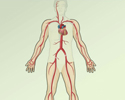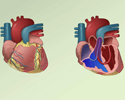Ebstein anomaly
Ebstein's anomaly; Ebstein's malformation; Congenital heart defect - Ebstein; Birth defect heart - Ebstein; Cyanotic heart disease - Ebstein
Ebstein anomaly is a rare heart defect in which parts of the tricuspid valve are abnormal. The tricuspid valve separates the right lower heart chamber (right ventricle) from the right upper heart chamber (right atrium). In Ebstein anomaly, the positioning of the tricuspid valve and how it functions to separate the two chambers is abnormal.
The condition is congenital, which means it is present at birth.
Causes
The tricuspid valve is normally made of three parts, called leaflets or flaps. The leaflets open to allow blood to move from the right atrium (top chamber) to the right ventricle (bottom chamber) while the heart relaxes. They close to prevent blood from moving from the right ventricle to the right atrium while the heart pumps.
In persons with Ebstein anomaly, the leaflets are placed deep in the right ventricle instead of the normal position. The leaflets are often larger than normal. The defect most often causes the valve to work poorly, and blood may go the wrong way. Instead of flowing out to the lungs, the blood flows back into the right atrium. The backup of blood flow can lead to heart enlargement and fluid buildup in the body. There may be narrowing of the valve that leads to the lungs (pulmonary valve).
In many cases, patients also have a hole in the wall separating the heart's two upper chambers ( atrial septal defect ) and blood flow across this hole may cause oxygen-poor blood to go to the body. This can cause cyanosis, a blue tint to the skin caused by oxygen-poor blood.
Atrial septal defect
Atrial septal defect (ASD) is a heart defect that is present at birth (congenital). As a baby develops in the womb, a wall (septum) forms that divide...

Ebstein anomaly occurs as a baby develops in the womb. The exact cause is unknown. The use of certain drugs (such as lithium or benzodiazepines) during pregnancy may play a role. The condition is rare. It is more common in white people.
Symptoms
Symptoms range from mild to very severe. Symptoms develop soon after birth, and include bluish-colored lips and nails due to low blood oxygen levels. In severe cases, the baby appears very sick and has trouble breathing. In mild cases, the affected person may be asymptomatic for many years.
Symptoms in older children may include:
- Cough
- Failure to grow
- Fatigue
- Rapid breathing
- Shortness of breath
- Very fast heartbeat
Exams and Tests
Newborns who have a severe leakage across the tricuspid valve will have a very low level of oxygen in their blood and significant heart enlargement. The health care provider may hear abnormal heart sounds, such as a murmur, when listening to the chest with a stethoscope.
Tests that can help diagnose this condition include:
- Chest x-ray
- Magnetic resonance imaging (MRI) of the heart
- Measurement of the electrical activity of the heart (EKG)
- Ultrasound of the heart (echocardiogram)
Treatment
Treatment depends on the severity of the defect and the specific symptoms. Medical care may include:
- Medications to help with heart failure, such as diuretics
- Oxygen and other breathing support
- Surgery to correct the valve
- Replacement of the tricuspid valve. This may be needed for children who continue to worsen or who have more serious complications.
Outlook (Prognosis)
In general, the earlier symptoms develop, the more severe the disease.
Some patients may have either no symptoms or very mild symptoms. Others may worsen over time, developing blue coloring (cyanosis), heart failure, heart block, or dangerous heart rhythms.
Possible Complications
A severe leakage can lead to swelling of the heart and liver, and congestive heart failure .
Congestive heart failure
Heart failure is a condition in which the heart is no longer able to pump oxygen-rich blood to the rest of the body efficiently. This causes symptom...

Other complications may include:
- Abnormal heart rhythms (arrhythmias), including abnormally fast rhythms (tachyarrhythmias) and abnormally slow rhythms (bradyarrhythmias and heart block)
- Blood clots from the heart to other parts of the body
- Brain abscess
When to Contact a Medical Professional
Call your provider if your child develops symptoms of this condition. Get medical attention right away if breathing problems occur.
Prevention
There is no known prevention, other than talking with your provider before a pregnancy if you are taking medicines that are thought to be related to developing this disease. You may be able to prevent some of the complications of the disease. For example, taking antibiotics before dental surgery may help prevent endocarditis.
References
Kliegman RM, Stanton BF, St Geme JW, Schor NF. Cyanotic congenital heart lesions. In: Kliegman RM, Stanton BF, St Geme JW, Schor NF, eds. Nelson Textbook of Pediatrics . 20th ed. Philadelphia, PA: Elsevier; 2016:chap 430.
Warnes CA, Williams RG, Bashore TM, Child JS, et al. ACC/AHA 2008 guidelines for the management of adults with congenital heart disease: a report of the American College of Cardiology/American Heart Association Task Force on Practice Guidelines (writing committee to develop guidelines on the management of adults with congenital heart disease). Circulation . 2008;118(23):e714-833. PMID: 18997169 www.ncbi.nlm.nih.gov/pubmed/18997169 .
Webb GD, Smallhorn JF, Therrien J, Redington AN. Congenital heart disease. In: Mann DL, Zipes DP, Libby P, Bonow RO, Braunwald E, eds. Braunwald's Heart Disease: A Textbook of Cardiovascular Medicine . 10th ed. Philadelphia, PA: Elsevier Saunders; 2015:chap 62.
-
Congestive heart failure overview
Animation
-
Congenital heart defect overview
Animation
-
Ebstein's anomaly - illustration
Ebstein's anomaly is a congenital heart condition which results in an abnormality of the tricuspid valve. In this condition the tricuspid valve is elongated and displaced downward towards the right ventricle. The abnormality causes the tricuspid valve to leak blood backwards into the right atrium.
Ebstein's anomaly
illustration
-
Ebstein's anomaly - illustration
Ebstein's anomaly is a congenital heart condition which results in an abnormality of the tricuspid valve. In this condition the tricuspid valve is elongated and displaced downward towards the right ventricle. The abnormality causes the tricuspid valve to leak blood backwards into the right atrium.
Ebstein's anomaly
illustration
Review Date: 3/15/2016
Reviewed By: Scott I. Aydin, MD, Assistant Professor of Pediatrics, Albert Einstein College of Medicine, Division of Pediatric Cardiology and Critical Care Medicine, The Children's Hospital at Montefiore, Bronx, NY. Review provided by VeriMed Healthcare Network. Also reviewed by David Zieve, MD, MHA, Isla Ogilvie, PhD, and the A.D.A.M. Editorial team.




